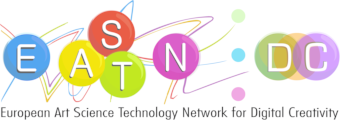This article provides an overview of the case-studies of the project Disembody , that examines diachronically questions concerning the body-space relationship through the lenses of virtual reality environments. Virtual fields propose a new posture towards more dynamic and interactive perception of the space, where the bodies (physical and virtual) are the generators of the space.
The hyper-real, extended body is an artificial-natural assemblage (e.g., Cameron, 2012), a metamorphic entity that constantly communicates the outside reality through perception with the inside existence (e.g., Islas, 2001) by proprioception. The emergence of augmented experience is materialized when the digital layer overlaps with the physical environment (e.g., Baudrillard, 2000) through interactive scenarios, performing extended encounters between the body and the space. In this vein, in performative technology of VEs (virtual environments), the bodies become the ultimate mediators, between time, space and perception.
The project’s objective is two-fold: (a) to analyse corporeal necessities-conditions in VEs (virtual environments), making use of both qualitative and quantitative metrics and employing as an instrument motion capture bodysuits, (b) to implement the findings of the empirical research toward the design of an experimental VR platform.
Our theoretical toolkit draws from architecture and contemporary research that are founded upon human corporeal experiences, grounded perception, and interaction. The notions of embodiment, body awareness, body space and proprioception (De Vignemont et al., 2005) have provided a real scientific breakthrough. Indicatively, the immersion in virtual reality environments is also used as a research tool in order to stimulate the senses, while a sensation of “being really in place” is surrounding the body (e.g., Chou, 2015), interfering with the sound and visual interaction stimuli, and in the overall embodied perception. As virtual reality environments offer high concentration of double entities, such as avatars/bodies, with physical and digital presence simultaneously grant the basis of the body-movement interconnection and an understanding of the relation between interaction engagement types and body-space research methodologies. Interaction engagement in VEs is closely related to full-body extended experience and it is perceived threefold: a) as the feeling of presence in the digital environment - fantasy -; (b) as affective aspects of human-human interaction - communication -; and (c) as regulatory properties of emotion - affect - (e.g., Bianchi-Berthouze et al, 2007).
The empirical stage of the project provides a methodological procedure to the exploration of body-space relation, focusing in four case studies-applications, using a headmounted device. The applications that have been selected - Blocks by Google , Freedom Locomotion VR , Kinese , Wave Beta - present imposed or allowed privilege of movement in different degrees, diverse types of natural or artificial interaction with the environment, fluctuations in complexity of geometrical representations and diversified narrative contexts. Thus, through contrasting different engagement interactive scenarios that are being experienced by the volunteers, a varied body-movement patterns are revealed in each participant and in every case study.
The research procedure is also implemented by a mixed type of instruments such as questionnaires, motion capture recordings of subjects’ engagement with VR and audiovisual registration via cameras. The analysis of the results arrange user profiles of post-humanity based indicatively on the notions of the body mereology (e.g., De Vignemont et al., 2005), the reflective and the pre-reflective body awareness (e.g. Legrand, 2007), the embodiment experience in VR (e.g., Gonzalez-Franco, 2018), and the foreground and background body experience in VR (e.g., Colombetti, 2011). These profiles are compared to motion capture data and audiovisual registration in order to define a kinesiologic vocabulary of body-movement-space correlation, regardless the variations in gameplay, interaction and immersion experience.
Results show that an increase body-movement scenario can afford to a stronger affective overall experience of immersion and thus a new exploration of materiality, de-subjectivity and corporeity. The questionnaires and the presented case studies have been structured in order to identify the wide range of implications and correlations between the body and the space that occupies, owns and generates. The motion capture technics and the audiovisual documentation provide the context of multimodal data flow to extrapolate the conclusions and consumptions of the overall research. The implementation of these findings has been proceeded upon a re-translation of body-space amalgam –named extendable meta-bodies- into a multiple VR interaction engagement patterns, resulting in a pilot application with gamified elements.
Back
“Reflections: Bridges between Technology and Culture, Physical and Virtual”
is supported by:






